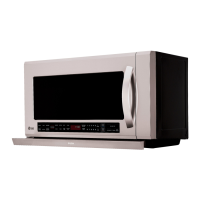STEP 2: PREPARE THE VENTING SYSTEM
NOTE: The ductwork you need for outside ventilation is not included with your oven. The standard ductwork
fittings and length are shown in Figure 10, page 9.
A, WARNINGA
THIS OVEN MUST BE PROPERLY VENTED!
You may vent your oven in one of three ways. Do NOT vent into a wall cavity, an attic, or an unused
area.
• Roof-venting If your oven is located on an outside wall near the roof, as in Figures 7 (3 1/4" x 10" duct) and
Figure 9 (6" round duct.)
• Wall-venting If your oven is located on an outside wall of your house, as in Figure 6 (3 1/4" x 10" duct) and
Figure 9 (6" round duct.)
• Room-venting If your oven is located on an inside wall of your house, as in Figure 8.
NOTE: If you choose the rear exhaust method (roof-or wall-venting), be sure there is enough clearance within the
wall for the exhaust duct.
cabinet
_.
Wail venting
Wall Venting
/,
3 1/4"x10" through-the-wall
duct
Figure 6
Roof Venting
oven _,
Roof venting
roof cap _._
3 1/4"x10"
duct
through-the-roof
Figure 7
REMEMBER AS YOU INSTALL THE
VENTING:
• Keep the length of the ductwork and the
numberof elbows to a minimum to ventilate
your oven efficiently. See examples on page 9.
• Keep the size of the ductwork the same.
• Do not install two elbows together.
• Use duct tape to seal all joints in the duct
system.
• Use caulking to seal the exterior wall or roof
opening around the cap.
cabinet
OVE
RoomVenting
Figure8
roof cap
round duct
elbow
3 1/4"to round
duct transition
wall cap
3 1/4" to round
ductwork transition
Figure 9
-8-

